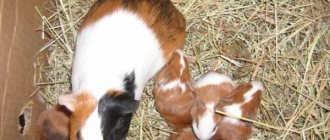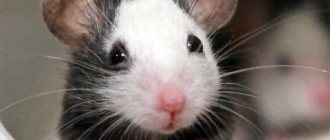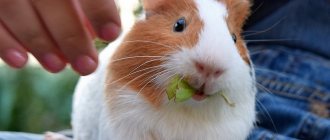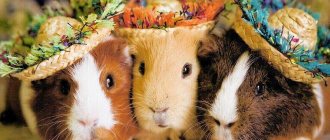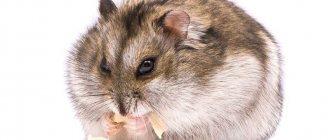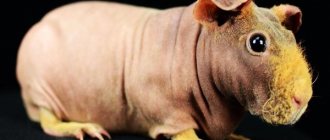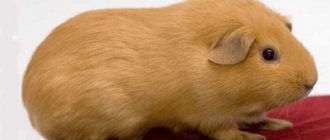A baby rat is born completely helpless. All he can do is suck the female’s milk. But within 3 weeks, the tiny creatures become independent animals, ready for the full life of a rodent. The baby rats in the photo at different ages allow you to see the rapid growth trend of the animal, significant transformations every day.
Rodent development stages
Appearance of little rats
Rats give birth to up to 15 cubs at a time. It’s worth paying tribute to, these animals make wonderful, caring mothers. From the moment the offspring are born until they reach the age of one month, the female is constantly with her babies. In addition to the fact that in the first days of life she serves as the only “feeder” for the rat pups, the mother constantly warms them with her body. Since there are quite a lot of babies, the rat takes turns moving them, changing places, so that everyone gets a piece of warmth. The body temperature of the cubs drops very quickly without the mother's body, which is why they can freeze and die.
Newborn rat pups are cute, defenseless creatures. They are born completely naked, without any signs of fur. Their eyes and ears are closed, but their sense of smell and instincts direct them to their mother's nipples with milk. The limbs are not yet fully formed, and the tail is very short; unlike adult rodents, the rat pups resemble small pink dolls with translucent pink skin and a large head.
Important! Immediately after birth, the babies should not be picked up, otherwise the female will abandon them or even eat them.
Interestingly, almost immediately after birth you can determine what the color of the rodent will be. Take a close look at the eyes. Although the baby is still completely blind and his eyeballs are covered with thin skin, through it you can see their color. If you notice black balls, it means the animal’s coat will also be dark. If the color of the eyes merges with the skin, the little rat will be light: white, beige or reddish.
The tiny body of a newborn rat pup weighs only about 4–6 g. It is already possible to tentatively guess the sex of the cubs based on their length. Males have a slightly larger body, can reach 9 cm, while females have no more than 6 cm.
How is it different from a mouse?
Newborn rodents of different species are often confused with each other. The little ones are very similar to each other, but there are still many differences between them. An attentive person will quickly determine by the appearance of the babies exactly whose nest he was lucky enough to discover.
Rat cubs from mice are distinguished according to the following criteria:
- Size. The body of a newborn baby rat will be longer than that of a mouse.
- Muzzle. In a baby rat, it seems to be chopped off and has bulging eyes covered with skin.
- Ears. In the vole they are round and large.
- Tail. Mice have a long and thin tail. It is equal to the length of their body.
The baby rats in the photo will be larger in size. They are slightly thicker and darker than a newborn vole.
How baby rats grow day by day
Watching newborn rat pups for the first time, you will be extremely surprised at how quickly their development occurs. Unlike a person, who needs a fairly long period of time to become a more or less independent being, baby rats, already 4-5 weeks after birth, have the qualities of an adult. This is largely due to the quality of the female's milk, which contains up to 9% protein, 9.5% fat and about 4% lactose. By comparison, human milk contains only 1.5% protein, 3.2% fat and 6.5% lactose.
Did you know? Newborn rat pups have very weak intestines, which causes problems with bowel movements. The female gives them a stimulating massage, licking their bellies.
If we consider the development process of newborn rat pups day by day, it happens something like this:
- 1 day - all that the pink, well-fed caterpillars can do is actively search for the mother’s nipple and saturate the body with nutritious milk;
- Day 2 - babies continue to eat, sleep, and sometimes make a faint squeak;
- 4–5 days - by this time, a change in the color of the skin occurs, on which spots of the future color of the fur coat can be seen. By the way, there may even be small hairs all over the body. By the fifth day, the animals’ ears open, they can already hear everything that is happening around them;
- 8-10 days - babies are already quite active. Although the coordination of movements is not yet fully formed, they can already start fights for the mother's nipple. Sometimes it happens that with a large brood, the place at the “feeding trough” is occupied by stronger animals, and weak ones can simply die without food. To prevent this from happening, you need to move the saturated rat pups into a separate enclosure for a short time, giving the other kids the opportunity to drink milk. In this case, you should definitely wear medical gloves, and provide the displaced children with a warm heating pad. The baby's body is covered with neat soft fur;
- 12–14 days - by this age, the cubs are already teething, and many of their eyes are also opening. The appearance of an additional sensory organ makes rat pups more inquisitive. Now they can’t sit still - the animals are trying to explore everything that surrounds them. At the same time, the mother is constantly on alert, trying to gather the babies together;
- Day 16 - it is already possible to distinguish the sex of the pups, since the nipples of the females are clearly visible. Thanks to their already grown teeth, babies begin to actively try their mother’s food and not only it, but also any objects encountered along the way;
- 21 days - by the end of the third week, complementary foods can be introduced; some babies already manage to switch to adult food by this time, eating what is intended for their mother;
- Day 28 - by the end of the fourth week, you will already have fully formed baby rats. They feed on their own, and by this time the mother rat stops producing milk. Kids actively explore everything around them and happily make contact with people. It is interesting that in natural habitats, at the age of one month, a street rat pup is already capable of independently obtaining its own food and hunting.
How many days do it take for eyes to open?
Small rodents open their eyes around the end of the second week. For some it happens a few days earlier or later. The ability to not only sniff, but also examine the world around them makes babies even more active and inquisitive. They constantly strive to get out of the nest, but the caring female does not lose her vigilance, moving the cubs closer to herself.
The eyes of rats are slightly bulging and located on the sides of the head. This structure gives rats a large overview - the animals, without turning their heads, can see everything that is happening around them, as well as above and below. In this way, Mother Nature made sure that animals could see danger approaching them in time in the form of birds of prey and animals.
Younger age
From the fourth day, the development of baby rats occurs at a rapid pace.
- 4th day, ears are open, the pups begin to distinguish sounds, hear rustling;
- the sixth body is covered with soft dark down;
- 8 teeth are trimmed, except for the main incisors.
After 10 days of life, puppies become active. They crawl well and master the territory. If these are pets, they need to be touched more often so that the animals grow up tame. However, during the game they should not be left unattended, since coordination of movements is not yet developed, children can fall to the ground from the table, from any hill.
How to care for baby rats
The total growth period for a rat is one year. During this time, the animal reaches the size of an adult: males weigh up to 600 g, and females - about 300 g. However, the foundation for full development is laid at a very early age. The cage with the female and newborn rats should be placed in the quietest and warmest room, where no one will disturb the family.
Don't worry about cleaning the nest - the mother rat will do it herself. You only need to periodically place new dry wipes in the cage, and the rat itself will throw dirty bedding into the corner. Only when the baby is 8–10 days old can you intervene in the cleaning process, carefully removing the waste material. This is only permissible if the female does not worry too much. Otherwise, cleaning should be postponed.
What do little rats eat?
The growth and development of cubs is largely influenced by the quality of nutrition. While staying near the mother for the first month, the basis of the diet is her milk. In order for it to be as beneficial as possible for babies, it is important to organize a balanced diet for the mother: in addition to the main food, the daily diet must include fruits, herbs, and animal food. Be sure to make sure that the female has enough water to drink - wash the drinking bowl and change the water daily.
Sometimes it happens that the female dies during childbirth, and if you cannot find her replacement (another nursing mother of a rat or mouse), you will have to do this yourself. Feeding newborn rat pups is not easy. For this purpose, dry infant soy formula, which is diluted with goat's milk, is best suited. Alternatively, you can use a pet milk replacer. Food is given to babies through a syringe. For convenience, you can equip it with a fabric pacifier.
Important! Little rats should not be given tomatoes, cucumbers and champignons, as well as any sweets.
In the first week you need to prepare the mixture as liquid as possible. Feedings are carried out every 2 hours during the day and a couple more times at night. In the second week, you can add ground grain feed to the mixture. Feeding periods are shortened - food is served every 4 hours. At week 3, the grain feed is simply mixed into the mixture and poured into a bowl. The cubs are already quite capable of eating it on their own.
By the end of the first month, a sufficient amount of protein should be present in the diet of rat pups, since a lack of this substance often leads to illness and mortality. The most useful additives: cottage cheese, boiled fish, apples, boiled chicken wings, egg yolks. Young rodents eat a lot: on average, their daily portion of grain is 80–100% of the weight of the animal itself.
Food preferences
Every pet rat has its own favorite treat. Some animals prefer insects. They can be given mealworms, which can be purchased at your local pet store. Other rats love to eat sweets. They should not be abused, because... they are high in calories. It is better to use treats as a reward during the training process. They can also be given after medical procedures or during periods of illness. A tasty treat should be safe for your pet. Apples are suitable as a treat. It is forbidden to feed the rodent smoked sausages, alcohol, chocolate, carbonated drinks, canned goods and leaves of indoor plants.
How long after birth can you pick up
Seeing small newborn lumps swarming around an adult female, you just want to pick them up or at least touch them. Under no circumstances should this be done. Firstly, their body is still very fragile and the slightest wrong movement or compression can lead to injury to the baby. Secondly, after you hold the baby in your hand, its coat will acquire a specific human smell. Mother rats often abandon such babies: they stop taking care of them, don’t feed them, and don’t keep them warm. The result is inevitable death. Despite all the caring behavior of females towards their offspring, they can kill a baby that emits an alien odor.
You will be interested to know what to do if decorative rats fight among themselves.
By three weeks, babies already look strong enough and can eat “adult” food. Even if the female does not want to accept a cub that smells like a human, it will be able to live and feed on its own. Experienced rat breeders recommend not delaying the taming of decorative rats. When the animal is a month old, it needs to be taken as often as possible, then the baby will be more obedient and affectionate.
Factors affecting reproduction
In the wild, the number of times a rat gives birth per year is influenced by climatic conditions, availability of food in the right quantities, natural disasters, and environmental conditions. We must not forget that natural selection allows only strong cubs to survive.
At home, despite the fact that rats are not so dependent on external factors, breeders try to limit the number of pregnancies, since frequent births affect the health of pets.
The birth of healthy rat pups and their number are influenced by the air temperature in the apartment, humidity, balanced nutrition, and stressful situations. Genetic factors also play a role. Spontaneous mutations and hidden recessions may occur.
When can you give?
The minimum age at which a small rat can be transferred to other owners is 5-6 weeks. At this age, he is already completely independent, has all the necessary life skills. Until this time, the animal must stay with its mother as part of the brood, since under these conditions it will have to learn everything it will need in adult life, for example, to arrange a home and build a nest.
There is also no point in delaying the transfer of the animal to another owner. Firstly, even if you are not going to give away the babies, at the age of 5-6 weeks you will need, at a minimum, to seat the females and males in different houses, since they will already be ready for mating. Secondly, the younger the animal, the easier it gets used to its new owners. Relocation to a new home occurs with virtually no fear or stress for the animal.
Did you know? During a stressful situation, a baby rat is capable of producing a sound equal in volume to a working jackhammer, but due to the ultra-high frequency, a person cannot hear it.
What not to give
Often, owners of baby rats try to pamper the younger generation with something tasty. However, most delicacies from the human table are dangerous for rodents, especially for babies. The following are strictly prohibited:
- sugar and sweets - candies, milk chocolate, baked goods, ice cream, condensed milk;
- fatty meat, lard;
- semi-finished products - dumplings, dumplings, cutlets;
- sausages, sausages, smoked meats;
- fast food;
- dried, smoked, dried fish;
- fresh milk;
- mushrooms;
- radishes, beans, turnips, rhubarb;
- carbonated drinks.
You also need to carefully monitor the baby rats so that they do not eat forbidden foods. Some plants, for example, can be deadly for rats - aloe, lily of the valley, dieffenbachia, geranium, carnation, lupine, tulip.
A new addition to a rat family is a very important and responsible event. Knowing what to feed baby rats and how to care for them, even a novice breeder can raise healthy and active offspring without any problems.
Location
Where the black rat lives is a very interesting question. The favorite habitat for the rodent is sea vessels. Rats live side by side with humans and eat identical food. They spread around the globe thanks to water transport.
The black rat is less inventive than its relative the Pasyuk. Content with little. Settles near reservoirs and rivers. But it is less attached to water than the gray one. Does not build nests in the ground, avoids water, but if necessary, swims quite a long distance. It does not dive because fish, fry, and amphibians are of little interest to it.
Willingly settles in the forest, fields, and edges. The lifestyle is more reminiscent of voles. In urban areas, it prefers sewers, abandoned buildings, garages, garbage cans, and entrances. Can live in a person’s house, occupying the upper floors or attic.
Prevention
When a rat has no problems and is not sick, its eyes, nose and mucous membranes are absolutely clean. When there is porphyrin in your pet's nose (for no reason), your pet requires the attention of a specialist. At the veterinary clinic, they will take tests and examine the animal, as a result of which it will be possible to understand whether everything is normal or whether there is a disease. In the latter case, the doctor will prescribe treatment at home or prescribe procedures at a veterinary institution.
To prevent the animal from developing bad symptoms, the owner must follow the following rules:
- the cage with the pet should be located in a quiet, calm place - the animal needs comfort;
- The animal should not be stressed, make noise, shout or wake it up abruptly - this will scare it;
- the rat must be fed healthy and wholesome food;
- You constantly need to monitor your pet, its condition, skin and mucous membranes.
Features of behavior
The character of these animals cannot be called simple. Siamese are characterized by alertness. If the animal has a bad upbringing, then it may attempt to bite its owner. This behavior needs to be stopped and try to find a common language with your pet as quickly as possible. To do this, you can use the following tips:
- from childhood, an animal needs to be picked up, talked to, called by name, so to speak, tamed and established contact;
- aggressive behavior of a rat can be stopped by light blows on the face, shouting or clicking on the nose;
- from the first minutes of communication you need to show that you are in charge.
Coat color
There is a wide variety of colors and coat tones for decorative types of rats. Based on this criterion, they are divided into groups.
Homogeneous
With uniform coat color in decorative rats, all hairs should look the same and be the same color.
The following colors are available:
- black;
- white (albinos);
- Russian blue and smoky blue, which differ only in the intensity of the tone;
- brown-gray;
- platinum;
- beige;
- champagne
There are several types of light gray color:
- with a blue tint (Russian silver);
- with a pink tint (dav);
- with a chestnut tint (lilac);
The name of the color is also determined by the color of the eyes. For example, rats with champagne coat colors should have pink eyes. And in white decorative rodents they are red and black.
Ticked
Each fur of such a rat is colored in several colors:
- Agouti. The basis of the classic color is soft brown hairs with black tips. A silver-gray tone predominates on the belly. Blue agouti is characterized by a combination of brown with silver or cool blue color. The platinum agouti has light gray and beige hairs that are effectively complemented by a blue tint.
- Amber. An ivory band is visible on the orange and fiery yellow hairs. The undercoat is a delicate cream color, the eyes are pink.
- Cinnamon. On the back, red-brown hairs with a bright golden edging predominate, and on the belly, gray and silver hairs predominate.
- Faun. The predominance of coffee-golden color, the silvery tint to which is given by guard hairs. The fur in the belly area is silver-cream in color. Fauns have dark ruby eyes.
- Topaz. Light coffee hairs are combined with silver ones. In color, these rats resemble fauns, but have a lighter shade of undercoat, due to which the entire color of the coat appears less saturated. Most often, they can only be distinguished by specialists who know what color these two types of rats are.
- Pearl. The color contains beige, golden and gray shades. The belly is sandy, with a grayish tint.
Silver
A peculiarity of this type of rat is the combination of hairs colored silver and other colors in equal proportions. The fur of such rodents must shine and sparkle.
A silver tint can set off a black, blue or brown tone.
Combined
This type includes rats whose color contains 2 or more shades:
- Siamese. The rodent's fur is beige in color, which becomes more saturated in the back of the body. The tail is uniformly dark. Brown spots are located on the face, ears and the bottom of the paws.
- Himalayan. The uniform snow-white coat has dark brown spots. A special feature is the red eyes. Black-eyed Himalayan rats have cream-colored spots.
- Burmese. The main coat color on the body can vary from sandy to brown, with darker spots on it. The tummy of rodents is distinguished by a gray-white color.
- Sable. The coffee color is combined with dark brown spots on the limbs.
Rats that combine white and colored parts of their fur in a certain order are called marked. The marking may take the form of a cloak, hood or train.
